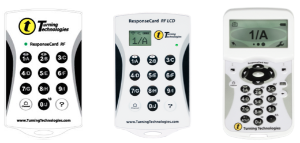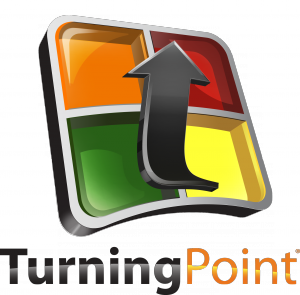
…that is the question. Today’s session led us to the Bay campus, where we were fortunate enough to be the first group to use the new PC labs. Unfortunately it did mean that we were unable to provide live streaming as the AV equipment wasn’t fully operational. There’s always a next time! The session was a brief introduction to clickers using TurningPoint Technologies which is a plugin for PowerPoint. So if you can use PowerPoint you can use Clickers! If you can’t, or haven’t yet, now is the time to try!
What are they though?
Clickers are an interactive technology that enable instructors to pose either spontaneously or ready prepared questions to students, and immediately collect and view the responses of the entire group.
A clicker system consists of three components:
- Clickers: wireless handheld transmitters (Radio, Bluetooth or WiFi are most popular);
- Receiver: a remote device that receives signals from the clickers, often a USB connection;
- Software: an application installed on the instructor’s computer to record, display, and manage student responses and data (TurningPoint is supported here in Swansea).
This is how clickers work:
- Instructors pose questions (verbally or with presentation software);
- Students submit their answers using their remote transmitters;
- The system instantly collects the results and saves the data, which can be view privately or shared with the group (anonymously).
But why bother?
What is the pedagogical value of using clickers?
No technology automatically enhances learning; rather, it must be used thoughtfully and deliberately to advance the learning objectives of a particular course. For example, an instructor in a large or medium-size class might choose to use clickers to:
- Elicit student participation and engagement to prompt deeper thinking about a particular question or problem.
- Monitor students’ understanding of course content in real time, in order to identify and address areas of confusion and adjust the pace of the course appropriately.
- Provide students with instant feedback on their comprehension to help them monitor their own understanding.
- Spark discussion among students as they compare, justify, or modify their answers.
- Efficiently deliver and monitor session test, to hold student accountable for readings and lecture material and assess basic factual knowledge.
Potential disadvantages of using clickers?
There is a plenty of research that demonstrates the learning advantages of using clickers. However, there are potential issues to consider:
- It can take an initial investment of time to learn to use the system and manage the data it generates; SALT can help you with this;
- Monitoring students’ understanding and responding appropriately requires flexibility and some loss of some predictability when delivering lectures;
- Using clickers takes time, so needs to be planned for;
- Creating good concept questions (in particular, questions that help you diagnose misconceptions) can be challenging.
To download ideas for using Clickers in your sessions click this link Why use Clickers and get the TurningPoint User Guides for more technical advice.



